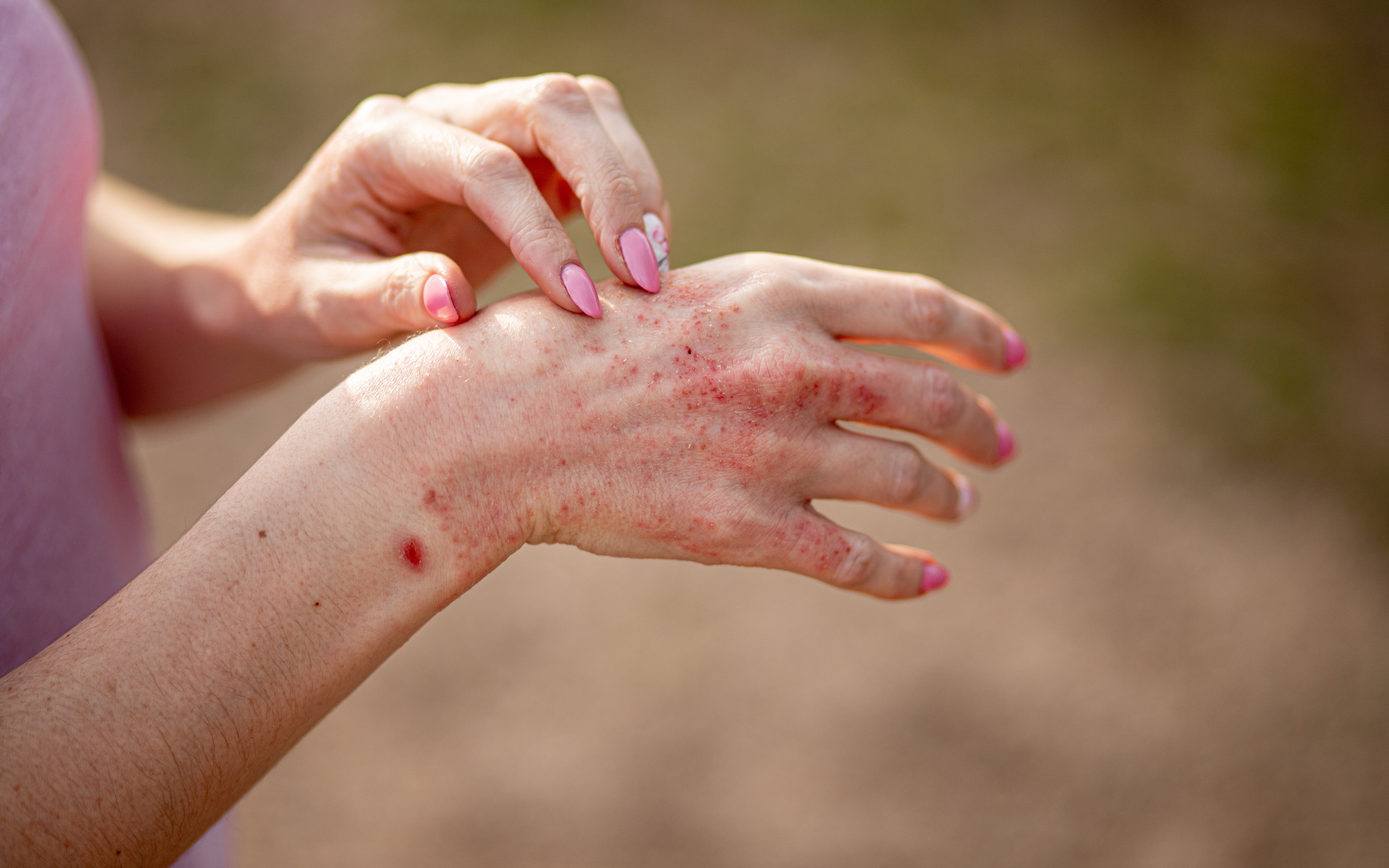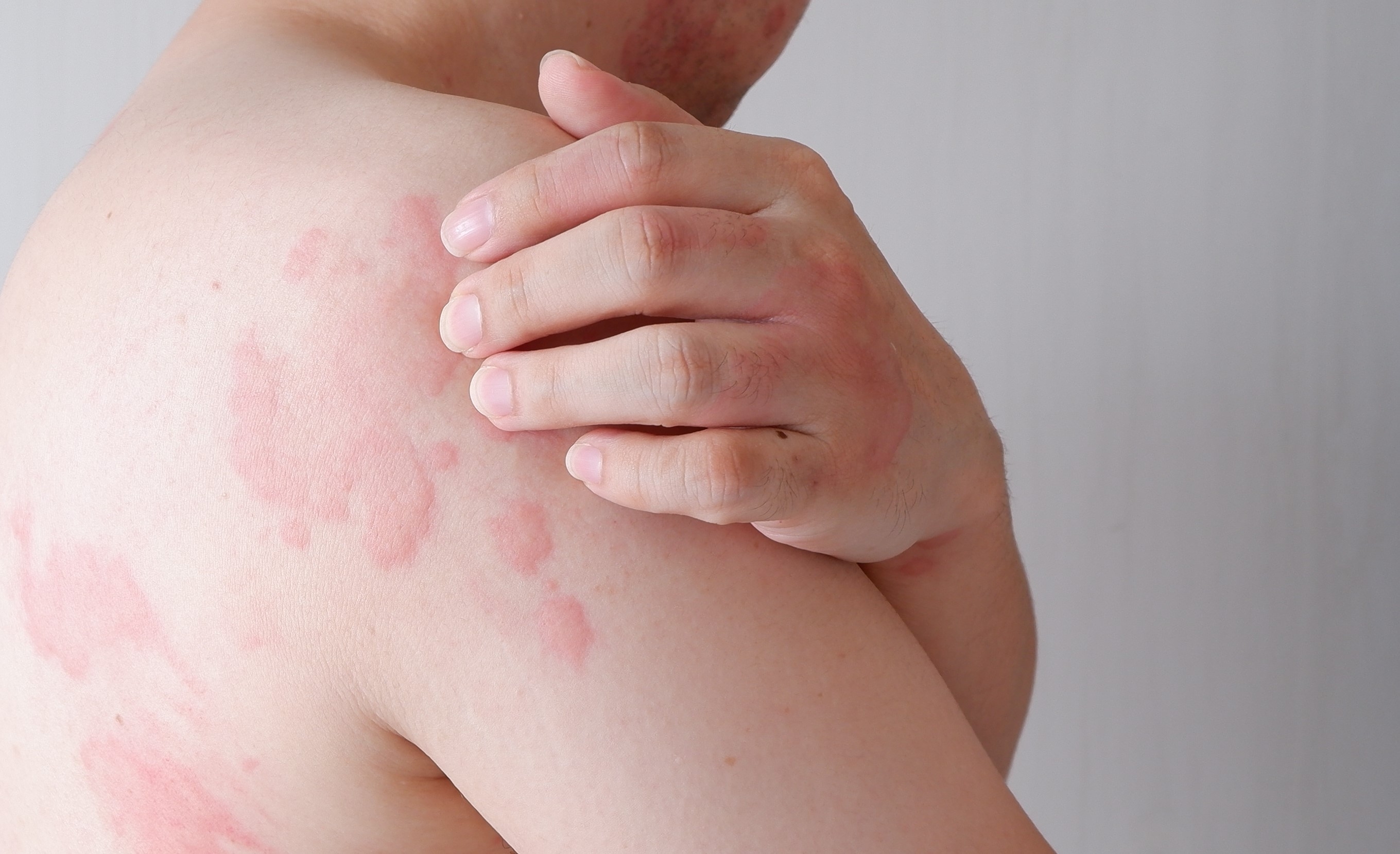![[media-entity-reference:media-alt]](/sites/g/files/zrelqx136/files/styles/billboard_tablet/public/media/images/2023/Man%20blowing%20his%20nose.jpg?h=34968951&itok=qcLWhZsR)
![[media-entity-reference:media-alt]](/sites/g/files/zrelqx136/files/styles/billboard_desktop/public/media/images/2023/Man%20blowing%20his%20nose.jpg?h=34968951&itok=rSD0ipaA)
What Are Allergies?
Location
Midvalley Health Center
243 E 6100 S
Murray, UT 84107
An allergy happens when your immune system mistakes a normal, harmless substance for something that can cause illness. Your body then has an allergic reaction to this harmless substance—called an allergen.
Asthma is one type of allergic reaction. In fact, the most common kind of asthma is allergic asthma, or asthma that’s caused by allergies.
At University of Utah Health Dermatology Services, we perform thorough evaluations for all types of allergies, including both delayed and immediate type allergies. Sometimes people with allergies become so used to chronic symptoms like sneezing, nasal congestion, and wheezing that they don't think their symptoms are unusual—or that their symptoms are interfering with their quality of life. However, an allergy specialist can help prevent or control these uncomfortable systems, improving how you feel on a day-to-day basis.
To schedule an appointment call 801-581-2955.
![[media-entity-reference:media-alt]](public://media/images/2024/allergy - front V3.jpg)
FAQs
Our number one priority is to keep patients safe. While immunotherapy can be very beneficial in relieving environmental allergy symptoms, it also comes with a risk of reactions. Typically, reactions to immunotherapy are local - redness, itching, and swelling of the injection site; however, systemic reactions can also occur - swelling of the throat, difficulty breathing, changes in blood pressure and heart rate. WE call this an anaphylactic reaction, which can be severe and life threatening. Studies show that anaphylaxis typically occurs within 30 minutes of the injection (hence the 30 minute post-injection waiting period); however, anaphylaxis can occur beyond that, which is why the allergist would like each patient to have an epinephrine auto-injector so they could treat an anaphylactic reaction if it occurred after the 30 minute waiting period, when you are no longer in clinic. Studies show the best treatment for an anaphylactic reaction is epinephrine. Carrying an epinephrine auto-injector will allow you to treat yourself for a reaction, if you are not in clinic, before seeking immediate medical care. Having an epinephrine auto-injector when doing immunotherapy injections are best practice.
- The allergists have begun prescribing epinephrine auto injector for their immunotherapy patients who have recently come in for an office visit.
- At your immunotherapy appointment, your MA will check to see if you have an Rx for an epinephrine auto injector. If you do not, they will ask you your preferred pharmacy and have your provider write you an Rx for an epinephrine auto injector to your desired pharmacy.
- You can also check your list of medications on mychart. If an epinephrine auto injector is not on there, please send your allergist a message to your indicated preferred pharmacy.
- Epinephrine auto injectors come in a pack of two. Best practice is to always keep both pens together in their pair; however, if you only bring one we will still give you your immunotherapy.
Out-of-pocket, epinephrine auto injectors cost about $200-400 for a pack of two; however, with insurance and/or coupons they are much cheaper. The cost for an epinephrine auto injector will vary based on your insurance plan. To find out the cost, call the number on the back of your insurance card. Another way to search for the pharmacy with the best price using Goodrx. You may go to the following website to search epinephrine auto injector prices at local pharmacies https://www.goodrx.com.
If you do your immunotherapy injections with family members, we will only require an epinephrine auto injector for the group as the likelihood of more than one of you having a reaction at the same time is extremely low. The allergists do want each immunotherapy patient to have their own Rx for an epinephrine auto injector.
Best practice is to have a non-expired epinephrine auto injector as studies show epinephrine loses potency over time. That being said an expired epinephrine auto injector is better than no epinephrine auto injector during anaphylaxis. If you have an expired epinephrine auto injector, the allergists would like to send an update prescription. If you bring an expired epinephrine auto injector to your immunotherapy appointment, we will still give you your immunotherapy injection.
Testing We Offer
- Allergy testing (skin prick)
- Patch testing (for foods)
- Fiberoptic sinus endoscopy
- Lung function tests
Treatment Options
We offer a number of treatments to help relieve allergy symptoms. Treatments include the following:
- Allergy shots (allergen immunotherapy)
- Rush immunotherapy
- Food allergy desensitization (oral immunotherapy, or OIT)
- Sublingual allergy desensitization
Find an Allergy Specialist Near You
Allergic Diseases
Research shows that the number of people who develop allergic diseases is rising. Today, 30–35 percent of people will develop allergies at some point in their lives. Factors like hormones, stress, smoke, perfume, or other environmental irritants may play a role.
Allergies can affect anyone, no matter your age, gender, or race. Allergies are common for children and adults and can happen for the first time at any age. Allergies can also return quickly and suddenly after many years of being allergy-free.
What Causes an Allergy Attack?
The human immune system defends itself against harmful substances like viruses or bacteria. But sometimes, your immune system aggressively attacks normal, harmless substances, such as food proteins or pollen, mistaking those proteins as foreign invaders.
During this process, your immune system overreacts, producing antibodies that cause your body to release histamines. These histamines then cause classic allergy symptoms like sneezing, itching, and watery eyes. Having an allergic reaction can affect your nose, lungs, throat, sinuses, ears, lining of your stomach, or skin.
There are two types of immune/allergic reactions:
- delayed reactions and
- immediate reactions.
Allergies: Delayed Vs. Immediate Reaction
Delayed reactions, or allergic contact dermatitis, is the most common type of allergic reaction that shows on the skin. Delayed allergies happen when different substances get on the skin and cause an itchy rash a day or two later.
Poison ivy rashes are a common example of delayed allergies. But your skin can also have a delayed reaction after shampoos, cosmetics, creams, earrings, and many other chemicals.
Immediate immune reactions are those in which substances, such as mold, dust, pollen, or animal dander cause swelling of the nose or sinuses, asthma, or itchiness of the eyes within minutes of your body being exposed to them. If you have seasonal allergies, your body is having an immediate reaction.
Symptoms of Delayed Reaction Allergies
- A rash that can be red, itchy, rough, scaly, or crusty
- A blistering reaction
- Swelling on your skin
- Redness and swelling in your mouth
Symptoms of Immediate Reaction Allergies
- Rhinitus (nasal stuffiness, sneezing, nasal itching, & nasal discharge)
- Allergic conjunctivitis (red, itchy, watery eyes)
- A flare-up of atopic dermatitis (red, itchy, dry skin)
- Asthma
- Hives
- Vomiting
- Abdominal pain
- Anaphylaxis
How Do You Get Tested for Allergies?
Dermatologists and allergists use several different types of tests to see if you have allergies. These tests include:
- patch testing,
- skin prick test or scratch test, and
- blood tests.
The type of test you will have will depend on what you may be allergic to and whether you have immediate or delayed allergic reactions.
What Is a Patch Test & What Is It Used to Diagnose?
Dermatologists use patch testing to see if you have a delayed allergy to certain items like perfume, latex, or metals.
Allergists use patch testing to see if you have delayed hypersensitivity reactions to foods. Food patch testing is especially useful for identifying triggers of eosinophilic esophagitis. Eosinophilic esophagitis causes an allergic reaction in your esophagus that makes it hard to swallow. To diagnose it, allergists use a type of food patch testing that’s similar to testing other types of allergies.
Patch testing is a three-visit process. At your first appointment, your dermatologist will apply several different types of allergens to your back with tape and then leave them in place for two days.
After two days, you will return for your second visit where your dermatologist will remove the patches. You will then go back to your dermatologist’s office two days after the removal for a third appointment to see if you have delayed reactions on your skin.
If you have a delayed allergic reaction, you will have red, swollen areas on your skin.
Skin Prick Tests
Your dermatologist or allergist will use a skin prick test to see if you have an immediate skin reaction allergy. Skin prick tests are also called scratch tests or puncture tests. These tests will let you know if you will have an immediate allergic reaction to pet hair, foods, and mold.
To do a skin prick test, your dermatologist or allergist will make a small scratch or prick in your skin and apply diluted allergens to your back or upper arm. Your dermatologist or allergist will be able to read the results in about 15-20 minutes.
Different types of blood tests can also test if you have immediate reaction allergies.
Pediatric Allergies
Children can develop seasonal allergies, asthma, eczema, and food allergies. Food allergies in children may be especially dangerous and even life-threatening. One in six children with food allergies has had an allergic reaction at school, and 25 percent of these children have never received an allergy diagnosis before.
Researchers have recently developed a way to make children with food allergies less sensitive to food allergens. This treatment is called oral immunotherapy. We now offer oral immunotherapy in our clinic.
What Is Oral Immunotherapy (OIT)?
During OIT, your child’s doctor will slowly introduce small amounts of an allergen to your child’s body to help your child create tolerance.
Oral immunotherapy is especially helpful for young children who have potentially life-threatening allergic reactions to things like peanuts as well as other nuts.
How Does It Work?
Even people with severe allergies can safely be exposed to tiny amounts of an allergen. This is called having a “threshold.” To start small, your doctor will introduce almost undetectable amounts of the allergen to your child’s body (for example, 1/40,000th of a peanut).
If your child doesn’t have an allergic reaction to this dose, your child will keep taking the same dose. Your child will then go to a doctor’s appointment every two weeks, where your child’s doctor will carefully increase the dosage and monitor them.
Is Oral Immunotherapy Safe?
Oral Immunotherapy has been tested in many clinical trials and is generally safe. But it’s common for children to have adverse reactions during treatment. Adverse reactions may include:
- oral itch,
- abdominal pain,
- vomitting,
- hives,
- asthma exacerbation, and
- rarely, life-threatening anaphylaxis.
Your doctor will lower your child’s chances of having a severe reaction by introducing allergens (or increasing the allergen level) in a controlled medical environment under physician supervision.
Is OIT Successful?
OIT has a success rate of over 80 percent. This means that over 80 percent of patients will be desensitized to a reasonable dose of the allergen. But it’s important to remember that being “desensitized” doesn’t necessarily mean that your child can safely eat the allergen in unlimited amounts.
After desensitization, your child’s doctor will probably continue to give your child a small dose of the allergen (called a "maintenance dose") for three to five years.
Should My Child See an Allergy Specialist?
Seasonal allergies and asthma can severely affect your child’s quality of life. If your child’s daily activities are limited by allergic disease, schedule an appointment with one of our providers.

















